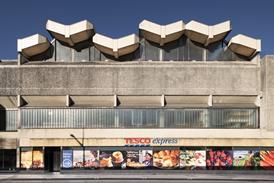Eleanor Jolliffe considers how conservation work and ongoing education are shaping her architectural practice and highlights themes for the profession in 2025

In looking ahead to next year, it would, of course, be tempting to give you seven or eight hundred words on the current UK economic circumstances and the challenges the profession currently faces. However, this will be news to no one and won’t help anyone, so instead I am looking for inspiration for next year in the growing pile of half-read and to-read architecture books slowly taking over my flat.
I have been getting drawn deep into twentieth-century buildings over the last eighteen months. I’m currently working exclusively on refurbishment, renewal, and retrofit projects and want to take the opportunity next year to increase my knowledge in this area. I have a handful of books I’ve read or half-read on the buildings I’m working on; some I am referring back to for a new book project; and others that I’m certain must have appeared by magic – I surely can’t buy this many books?!
Top of the list over Christmas to try and finish reading, or at the very least to make a much more sizable dent in, is Gavin Stamp’s Interwar. This beautifully written survey of interwar British architecture is helping me set into a wider context the buildings I’m working on and the thoughts of those who designed them. Twentieth-century architecture is a fascinatingly rich mixture of styles and philosophies, as yet not quite old enough to be truly fashionable to the wider public. The Twentieth Century Society has recently launched a ‘Coming of Age’ campaign to list the best buildings just turning 30 (and therefore eligible for listing). If you’re in need of persuading about some of the riches of our recent past, it is worth perusing.
It may take a little discipline to sit down to this, though, when I am so tempted to reread The Honeywood File for the tenth time (also set in the twentieth century, so it nearly counts!). While a truly fun read, it never ceases to amaze me how little has changed in the daily travails of the architect in the last ninety-five years. I’m still waiting for someone to write the updated version…
> Also read: Interwar: Gavin Stamp’s tribute to Britain’s forgotten architectural diversity
I also have the RIBA’s newly published Conservation Guide staring at me from the to-read shelf. This year I did their Advanced Conservation Course and am slowly working towards Conservation Architect accreditation, so I do need to read more broadly around the subject. I’m finding this style of practice absorbing in a very different way to the new builds I spent most of the first eight or so years of my career on. To work in this way requires a different discipline; it’s slower, more scholarly, and more collaborative with building craftspeople on site.
I can already feel the discipline of this style of practice improving the quality of my architectural work more broadly. It’s probably a discipline the profession more widely will need to take seriously in the coming years. Carbon cost-focused development is already increasing calls for more retrofit and refurbishment; a more restorative, repair-led approach seems likely to become an essential part of any architect’s professional toolkit.
Anyone who regularly reads this column knows that I am convinced that architects have become too far removed from the process of building. Therefore, using my conservation work as an excuse, I have finally (with the support of the practice I work for) enrolled on The Society for the Protection of Ancient Buildings’ Repair of Old Buildings course in May. The course is lecture- and site-visit-based and teaches everything from plasterwork and historic paints to services, stonework, and brickwork. Several colleagues have been on it in the past, and it seems there really is no substitute for learning ‘by hand’ from those that practise the art of these building repair techniques daily.
Considering the art form of construction and architecture from another angle is Farshid Moussavi’s approach to her coordination of 2025’s Royal Academy of Arts Summer Exhibition. The 2022 Jane Drew Prize winner has chosen ‘Dialogues’ as her theme for the world’s largest open submission contemporary art show and, for the first time, works of architecture will be integrated within the artworks rather than in their own room. Moussavi explains that this will allow the architecture to “creat[e] conversations with the art rather than being confined to its own space”. I’m intrigued by the idea while being simultaneously nervous that this may just reinforce the fetishisation of architectural images that I think has dragged us ever further from the craft of building. I look forward to (hopefully) being proven wrong.
I’m already sensing general themes in the next twelve months for my personal practice – but I wonder if an increasing focus on reuse and broadening our skill sets and ongoing education will form a focus for all of us. I haven’t mentioned the words Building Safety Act – but it’s already impacting my life substantially, and I imagine most readers too. I’m not anticipating a straightforward 2025, but I am hopeful for an engaging and forward-looking one. I hope it is for all those reading as well.
Postscript
Eleanor Jolliffe is a practicing architect and co-author of Architect: The evolving story of a profession
















No comments yet